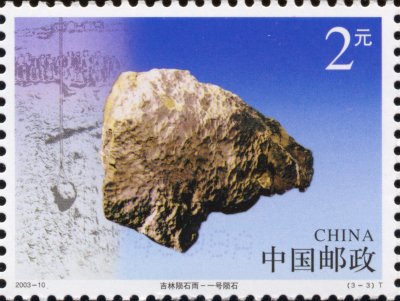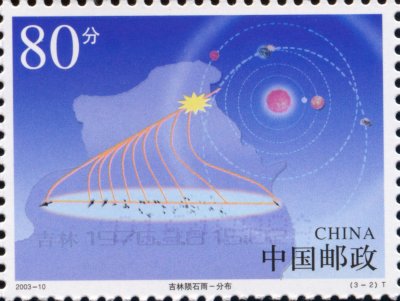
China (P.R.C.)

Denominazione ufficiale: Repubblica Popolare Cinese
Official name: People's Republic of China
Nome nella lingua originale: Zhonghuá Rénmín Gònghéguó
Superficie: 9.572.900 km²
Popolazione: 1.336.718.015 ab. (Luglio 2011)
Tipo di governo: Stato socialista a modello cinese
Capitale: Pechino
Moneta: Yuan cinese (renminbi)
Lingue ufficiali: Cinese mandarino, Cinese cantonese
Nascita: Indipendenza 1 ottobre 1949 dalla Repubblica di Cina
Area: Asia
Fuso orario: UTC +8
Prima emissione: 1949
Ultima emissione: Attuale
Per saperne di più: http://it.wikipedia.org/wiki/Cina
Annotazioni: Ingresso nell'ONU 25 ottobre 1971.

Soggetto: the Jilin meteorite shower Anno: 2003 Notizie: On June 21, 2003 the Peoples Republic of China issued three stamps depicting the fall of the Jilin meteorite shower. A first day cover bears all three stamps and a cachet depicting a meteorite shower superimposed on the outline of the largest recovered specimen of Jilin. At 15:01 Beijing time, on March 8 1976, a meteoroid massing around 15 tons entered the Earth's atmosphere at an angle of about 16 degrees and a speed of about 17 km per second. The meteoroid glowed brilliantly after entering Earth's atmosphere, appearing as a brilliant fireball to ground observers. The atmosphere acts as a very effective shield against stony objects of this size, slowing their cosmic velocities to a standstill and disrupting them. The usual result is that the meteoroid explodes spectacularly, like a brick hitting a stone wall. The Jilin object burst at a height of about 17 km above the northern suburbs of Jilin City in Jilin Province. This airburst registered as a magnitude 1.7 tectonic event on the Richter scale. 138 large stones and at least 3,000 smaller fragments rained down over a strewnfield measuring about 576 square kilometers in area (72 kilometers east-to-west by 8 kilometers north-to-south). Searchers recovered nearly four tons of meteorites from the Jilin fall. The largest single specimen of Jilin -- the main mass -- weighs in at a hefty 1,770 kg. It is the largest stone meteorite ever found. The main mass struck the ground at 15:02:36 near the western edge of the strewn field, just a couple of hundred meters away from a home. The impact produced a pit two meters wide and six meters deep. Two other large specimens weighing in a 400 kg and 123.5 kg landed fifteen kilometers east of the main mass. Incidentally, the largest known meteorite of any kind is Hoba, an iron meteorite which remains right where it fell in what is now Namibia. Jilin is classified as an H5 ordinary stony olivine-bronzite chondrite. This is one of the most common types of meteorites. Chinese tradition associated the fall of a meteorite with terrestrial happenings. Many saw the meteorite as presaging the death of Mao Zedong or the fall of the Gang of Four. Others suggested the fall heralded the devastation brought by the Tientsin-Tangshan earthquake which resulted in the deaths of 242,000 people. Still others linked the fall to the end of the the Cultural Revolution. The first stamp depicts the Jilin meteoroid breaking up in the atmosphere. The fragments are headed for China. The eventual strewn field appears as a rectangle on the globe. The background shows Jilin City's Songhua River and Jilin Bridge. |
|---|

Soggetto: the main mass of Jilin Anno: 2003 Notizie: The third stamp shows the main mass of Jilin as well as the impact pit it left upon landing. While the stamp description claims this is the largest meteorite ever found, it is not. It is the largest stone meteorite, but larger iron meteorites are known. |
|---|

Soggetto: the possible orbit the Jilin meteoroid Anno: 2003 Notizie: The second stamp depicts the possible orbit the Jilin meteoroid took to get to Earth along with the meteorite distribution area. A map of Jilin City and the time of the fall appear in the background. The light blue oval indicates the point at which the meteoroid exploded, and the area over which the meteorites scattered on landing. |
|---|